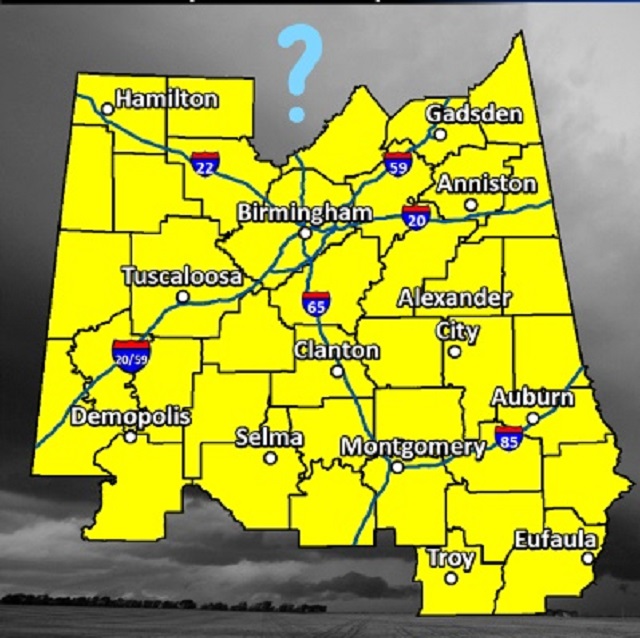Cullman County is in the Birmingham news market, but the Huntsville weather market. So what gives?
CULLMAN – When you watch weather reports on the news, depending on what channel you watch and what's going on up in the sky, you might notice that Cullman County sometimes appears to be exempt from weather issues in our neighboring counties. On the TV weather map, Winston and Blount Counties might be a fiery red or bright yellow, while in between is a Cullman-shaped void. Or Winston and Blount vanish, leaving Cullman County dangling like some unfortunate shark's last tooth. So, what's happening?
Cullman is caught in a sort of no-man's land between Birmingham and Huntsville, simultaneously claimed and rejected by both. Confused yet? It gets easier.
Cullman County is located in the Birmingham news market. A few providers make Huntsville stations available, but for the most part, we get our TV news from Birmingham. On the other hand, we are within the National Weather Service's Huntsville (NWSH) weather district, while Winston and Blount Counties belong to the National Weather Service's Birmingham center (NWSB). This means that the NWS maps and radar images used by TV news outlets in Birmingham will show Winston and Blount, but not Cullman. The opposite is true for the NWSH maps and images used by Huntsville stations.
How did this happen? The Tribune talked to NWSB's Warning Coordination Meteorologist John de Block, and NWSH's Meteorologist in Charge Chris Darden. In separate interviews, they gave similar accounts of Cullman County's assignment to Huntsville:
Originally, there was no NWS center in Huntsville. NWSB served the entire northern third of the state, so the news market and weather district were in sync. In the 1990s NWS underwent modernization, leading to a reorganization of offices and upgrade of equipment. One outcome of this modernization was the creation of NWSH.
During the process of creating the new office, decisions had to be made about who went where along the midway line between NWSB and NWSH. That decision fell to the counties themselves. According to both Darden and de Block, the Cullman County Commission, in coordination with Cullman County Emergency Management Agency (EMA), requested assignment to the new NWSH. Winston and Blount chose NWSB. De Block emphasized, "This was not an arbitrary federal decision."
So, we are in the Huntsville weather district because we (via the County Commission and EMA) asked to be, and we are in the Birmingham news market because we were before and never changed.
What does this mean for our weather coverage through media outlets? The Tribune spoke to WBRC's Chief Meteorologist J-P Dice in Birmingham for more on that.
Dice said, "WBRC covers 21 counties, including Cullman. Everybody, including the other stations, has Cullman on their maps."
The gaps and dangling shark's tooth appear when the TV stations are using radar and maps issued by the NWS offices. These appear during normal weather conditions and forecasts, and are also typically used for weather watch situations. Watches are not issued locally, but by the National Oceanographic and Atmospheric Administration's (NOAA) Storm Prediction Center in Norman, Oklahoma. These maps, when sent to news outlets in Birmingham, tend to omit Cullman County.
That changes when the weather situation shifts from a watch to a warning. Warnings are issued by local offices (NWSH for Cullman County), but all Birmingham media outlets are in touch with NWSH and will display needed information. Dice offered assurance that, during severe weather events, Birmingham TV news weather maps will display all current warnings for north Alabama, regardless of what office issues the warning.
So, if you want to know what the weather will be like the day after tomorrow or you're watching to see what that approaching front is going to do, you might need to look at Winston and Blount, and follow their lead. Online, you can go right to the NWSH source at http://www.weather.gov/hun/.
But if the skies are dark and foreboding, and you're concerned for your safety and that of your friends and family, you should be able to turn on any TV news station and get the crucial information you most urgently need.



























